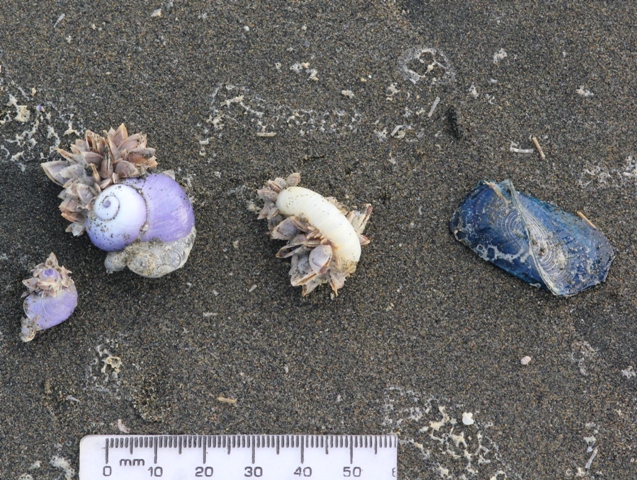Muriwai beach is just north of the Takapu gannet colony and as it had a motor camp right by it we decided to stay in spite of the high winds.
This black sand beach goes on for many kilometres is popular with wind surfers in all weathers. Indeed there were many doing amazing acrobatic jumps. At the same time I was keeping an eye on what was on the sand; after a while I realised that I was seeing violet sea snail shells which seemed to be alive.
The first time that I saw them it was after a storm on the Carrapateira beach, Parque Natural do Sudoeste Alentejano, Portugal, back in 2006. Then there were many rather small violet snail shells plus the remains of the by-the-wind sailors Velella velella and I just took a couple of pictures. Now that I had my chance to see them again I was positively ecstatic.
 |
| From the left, a couple of violet sea snails, one mystery white curled mollusc* and one by-the-wind sailor |
* Thanks to the help of Shaun Tamblyn I now know that this shell is known as Spirula. It is the the internal shell of the ram's horn squid. It is commonly found in the Western coast of Australia and New Zealand and I can attest to that! Fascinating! This shell must have hung around a while because it had barnacles growing on it.
The bigger snails had a very 'bubbly foot' and quite a few hitchhikers, identical to the ones growing on the spiral shell, some kind of barnacle [?]. The 'bubbly foot' is a raft that allows them to float. Apparently, the mucus used to produce the bubbles seems to be chemically stabilized so that it is long-lived and the bubbles do not burst. If they did the snail would sink and die. They are also blind.
They probably float upside down, thus the lighter colour is below, and that is also where the hitchhikers position themselves.
 | ||||||||
| A couple of live violet sea snails showing that the spiral side is lighter |
 |
| Close up of a large violet snail |
The beauty of this is that their shell has a lovely kink to it. Hopefully this will allow their identification. There are several Janthina species. My cousin João J. Castro who is a marine biologist, has shown me this page on the Marine Species Identification Portal
Janthina feed on things like the by-the-wind sailors, which had also a matching blue colour, see top photo. According to this page http://en.wikipedia.org/wiki/Janthina_janthina they also feed on the Portuguese man of war, and we did find one next morning. Now doubt it was brought in by the steady on shore wind.
 |
| Stranded Portuguese man o'war |
No comments:
Post a Comment